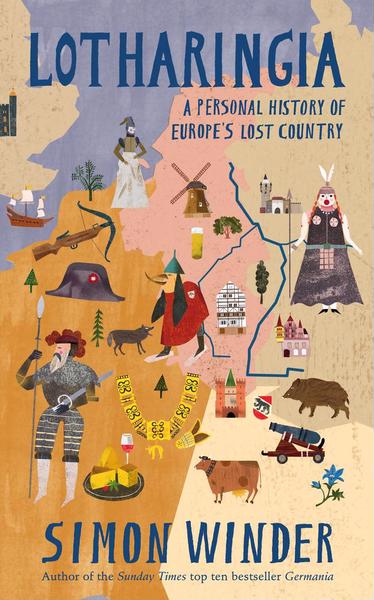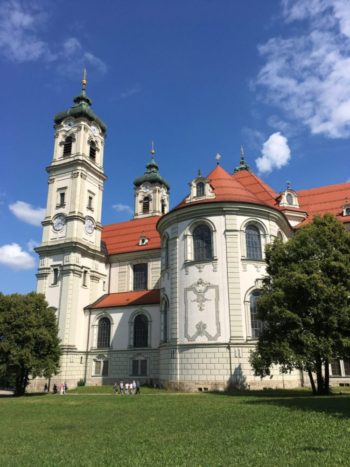As I have mentioned elsewhere, I am so enjoying reading Simon Winder’s new book, Lotharingia; A Personal History of Europe’s Lost Country. As with his other books, Germania and Danubia, I find myself laughing out loud at his fascinating explorations of the world of the Holy Roman Empire and its neighbours. This time he is revealing the history of those in-between lands, from the Netherlands south to Switzerland, that lie between what was the Holy Roman Empire and France.

I love Winder’s sense of humour and infectious sense of fun. I share that feeling of history as something wonderfully entertaining, as well as gripping, thrilling, moving, terrifying and vital to our understanding of our present. I’m delighted at finding someone else for whom the wilder shores of the Baroque are filled with joy and I, too, know that moment when exhausted companions peel away as I skip ecstatically round churches packed with endless – and increasingly mad – funeral monuments.
Last year, as we were driving north through Bavaria, I spotted a road sign for Ottobeuren. From the back of my mind came the dim ringing of a bell and I suggested to my long-suffering companion ( also driver)that we might make a small detour. It may not be something that he would like, I said (always better to be up-front and truthful about mad Baroque and Roccoco-ery, I feel), but we would only have a very quick look.

The Abbey Church of Ottobeuren
My mind had dredged up the idea of an abbey, but I was unprepared for the full grandeur of this completely over-the-top Benedictine foundation, large and white and dominating the surrounding town. It was, I discovered, one of the self-ruling abbeys of the Holy Roman Empire and had been founded in 764 by the Blessed Toto (which brings the whole camp wonderment of the Wizard of Oz and the full power of the Bavarian Baroque crashing together in one glorious cornucopia). In the early 1700s the present church and attendant monastery were built, the whole being designed by Johann Michel Fischer, one of the finest architects of Bavarian Baroque.
And, boy, is that basilica baroque! A glorious symphony of white, pink and gold, with flying angels, stucco clouds, pulpits like gaudy gazebos and full-scale jewel encrusted skeletons in crystal reliquaries beneath the altars. The painted ceilings soared; swathes of red and pink marble, carved into swirling festoons, waved and rocked; angels trumpeted while marble bishops simpered and everybody’s drapery seemed to be caught in a high wind. The whole effect was of giant wedding-cake icing that had taken over the world.

The Interior of the church at Ottobeuren
A sign led to the ‘Museum’, which turned out to be most of the vast monastery – beautifully and recently refurbished, immaculately kept, and almost as decorated as the church. Fabulous staircases lead to the Abbot’s apartments – much more suitable for a prince rather than an ascetic religious leader. There is a small theatre (!!) as well as a large ballroom – baby-pink with an apotheosis painted on the ceiling, an awful lot of icing-sugar angels and about twenty-four life-size gilt statues of various Holy Roman Emperors in stages of exaggerated rococo posturing.
Quite why a monastery should need a theatre, let alone a ballroom, remains to be seen. But it would certainly need a library, and that at Ottobeuren is perfect. Light and curvaceous, with delicate painted ceilings and pink marbled columns this is an exquisite setting for the Abbey’s books, bound in soft cream-coloured calfskin. An exuberant figure of Athena, helmeted but with flowing curls and more wind-blown drapery, stands on a plinth in the centre of the room.

The Library of Ottobeuren Monastery

One of the life-size statues of Holy Roman Emperors to be found at Ottobeuren
I adored Ottobeuren. For me the whole experience was entirely joyous, a wonderful three-dimensional uber-fest of over-the-top decorative fantasy. I can quite understand that it may be far too much for some people, but for me it is, above all, glorious FUN.
Years ago, whenever I called a building or an artwork ‘fun’ in my mother’s hearing she would object, saying that you couldn’t describe architecture or painting as fun. I think she felt ‘fun’ was something that you did, rather than something to be experienced through other things. A picnic might be fun, or a visit to the Pantomime, but certainly not a palace or (heavens above!) a church.
About a decade ago I had a conversation with people I knew very slightly, in the café at Tate Britain. One of them became very fierce when I described a work of art as ‘fun’. I can’t remember what work it was, but she announced that she loathed people who tried to make out that art was entertaining;
“It’s much more important than that!”, she announced. “I hate people like Sister Wendy, who popularise things and who are always trying to make people enjoy art by saying that it is fun. It’s not to be laughed at!”
Needless to say, this was not a friendship that was destined to prosper.
I yield to no-one in my belief that art is, indeed, highly important. It is meat and drink to me and to be in it, around it and with it is where I am happiest. It can be powerful, tragic and brutal (try Goya’s 3rd of May 1808 for a full-blown punch) or gentle and calm (maybe the landscapes of Corot?) and it can range through every emotion and state of mind, but that must include exuberance and joy. And the discovery of it all, finding out about it and making the links between one place and person and another, across time and space – well to me, that is fun. Just about the best sort of fun of all.
And that is what Simon Winder does so superbly well. Not only does he obviously get such pleasure from all he sees and learns, but he can articulate that in such a way that we can share that sense of delight in another piece of the jigsaw found or another link caught.
Simon Winder’s Lotharingia is published by Pan Macmillan (ISBN 978 1509803255). Germania (9780330451406) and Danubia (9780330522793) are both available in paperback and all three are very entertaining indeed.
